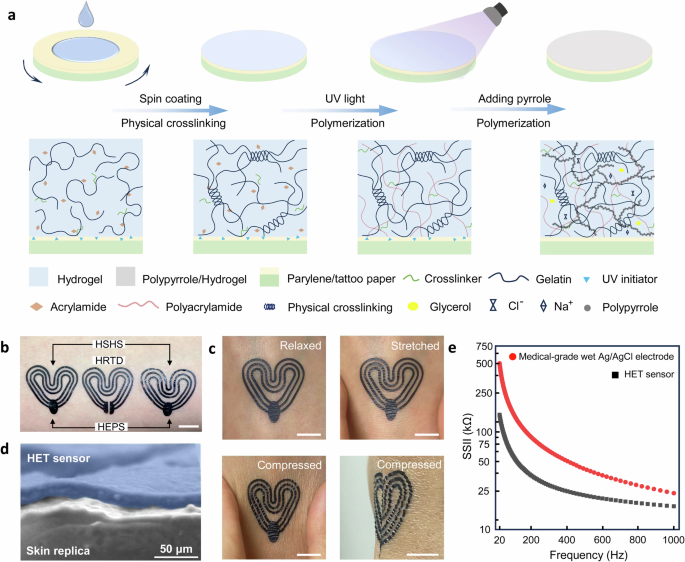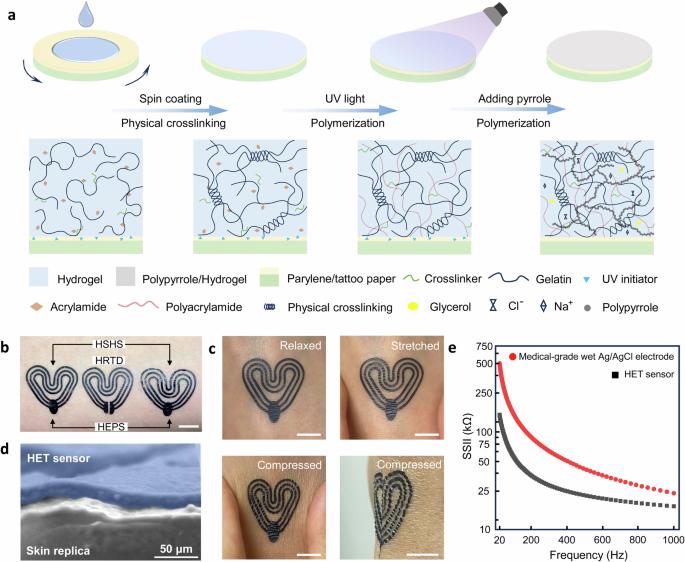Reusable free-standing hydrogel electronic tattoo sensors with superior performance
IF 12.3
1区 材料科学
Q1 ENGINEERING, ELECTRICAL & ELECTRONIC
引用次数: 0
Abstract
Recently electronic tattoo sensors have attracted immense interest for health monitoring mainly due to their higher sensing performance than conventional dry sensors, owing to the ultra-low thickness which results in their conformability to the skin. However, their performance is worse than wet sensors. Further, these electronic tattoo sensors are not durable and reusable when free-standing because of their low thickness and being too delicate. Here, we report a remarkably high-performance freestanding, reusable, ultrathin and ultra-soft electronic tattoo sensor made of parylene-hydrogel double layer system with high water retention over extended periods that can be used for the extended period of 6 months. The hydrogel electronic tattoo (HET) sensors consist of electrically conductive self-adhesive hydrogel with a thickness of 20 µm and Young’s modulus of only 31 kPa at 37 °C, allowing for ultra-conformal contact to the skin microscopic features. Our HET sensors are fabricated using a scalable cost-effective method on ordinary tattoo papers and are laminated on the skin like temporary tattoos and were used for electrophysiological signals recording such as electrocardiography (ECG), electromyography (EMG), and skin hydration, temperature sensing. The HET sensors, for the first time, show 234% lower sensor-skin interface impedance (SSII) and significantly lower susceptibility to motion than gold standard medical grade silver/silver chloride wet gel electrodes which are known to have the lowest SSII and susceptibility to motion. Further, the low HET-skin interface impedance leads to a considerably larger signal amplitude and signal-to-noise ratio (SNR) of the electrophysiological signals recorded using HET sensors in comparison with those obtained using gold standard medical grade silver/silver chloride wet gel electrodes. The SNR of some types of electrophysiological signals such as EMG recorded using HET is up to 19 dB higher than gold standard medical grade electrodes due to higher signal amplitude, significantly lower susceptibility of HET to motion and lower motion artifacts. Also, the HET sensor is the first free-standing ultrathin tattoo sensor that can be transferred from the skin to tattoo paper and vice versa many times and the electrophysiological sensing quality remained high during repeated use for over 6 months.


可重复使用的独立式水凝胶电子纹身传感器性能卓越
最近,电子纹身传感器在健康监测领域引起了极大的兴趣,这主要是由于电子纹身传感器的超低厚度使其能够贴合皮肤,因此其传感性能高于传统的干式传感器。不过,它们的性能比湿传感器差。此外,这些电子纹身传感器由于厚度低、过于脆弱,在独立使用时不耐用,也不能重复使用。在此,我们报告了一种性能卓越的独立式、可重复使用、超薄和超柔软的电子纹身传感器,它由对二甲苯水凝胶双层系统制成,具有较高的保水性,可长期使用 6 个月。水凝胶电子纹身(HET)传感器由导电自粘性水凝胶组成,厚度为 20 微米,37 °C 时的杨氏模量仅为 31 千帕,可与皮肤微观特征超适形接触。我们的 HET 传感器是在普通纹身纸上采用可扩展的低成本方法制造的,像临时纹身一样贴在皮肤上,用于记录电生理信号,如心电图(ECG)、肌电图(EMG)以及皮肤水合作用和温度传感。与已知具有最低 SSII 和运动敏感性的金标准医用级银/氯化银湿凝胶电极相比,HET 传感器的传感器-皮肤界面阻抗(SSII)首次降低了 234%,运动敏感性也显著降低。此外,与使用金标准医用级银/氯化银湿凝胶电极记录的电生理信号相比,HET-皮肤界面阻抗低导致使用 HET 传感器记录的电生理信号的信号幅度和信噪比(SNR)大得多。使用 HET 记录的某些类型的电生理信号(如肌电图)的信噪比比金标准医疗级电极高出 19 分贝,这是因为 HET 的信号振幅更高,对运动的敏感性明显降低,运动伪影也更少。此外,HET 传感器还是首个独立式超薄纹身传感器,可多次从皮肤转移到纹身纸上,反之亦然。
本文章由计算机程序翻译,如有差异,请以英文原文为准。
求助全文
约1分钟内获得全文
求助全文
来源期刊

npj Flexible Electronics
Multiple-
CiteScore
17.10
自引率
4.80%
发文量
91
审稿时长
6 weeks
期刊介绍:
npj Flexible Electronics is an online-only and open access journal, which publishes high-quality papers related to flexible electronic systems, including plastic electronics and emerging materials, new device design and fabrication technologies, and applications.
 求助内容:
求助内容: 应助结果提醒方式:
应助结果提醒方式:


